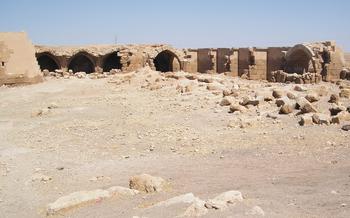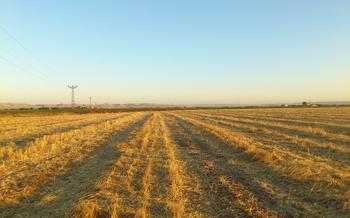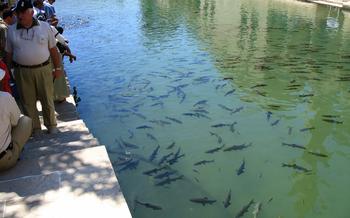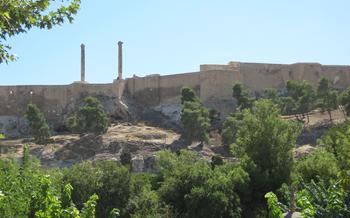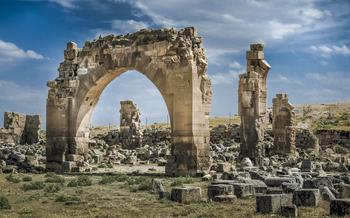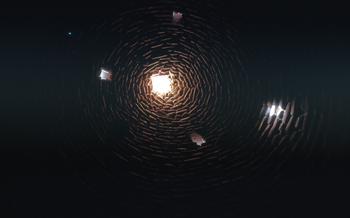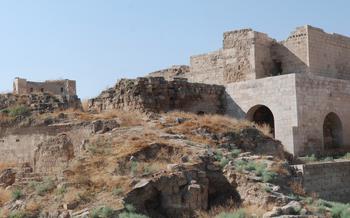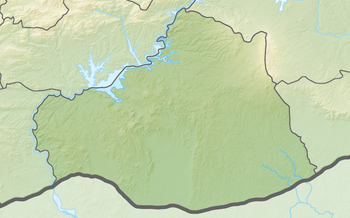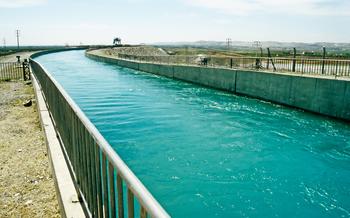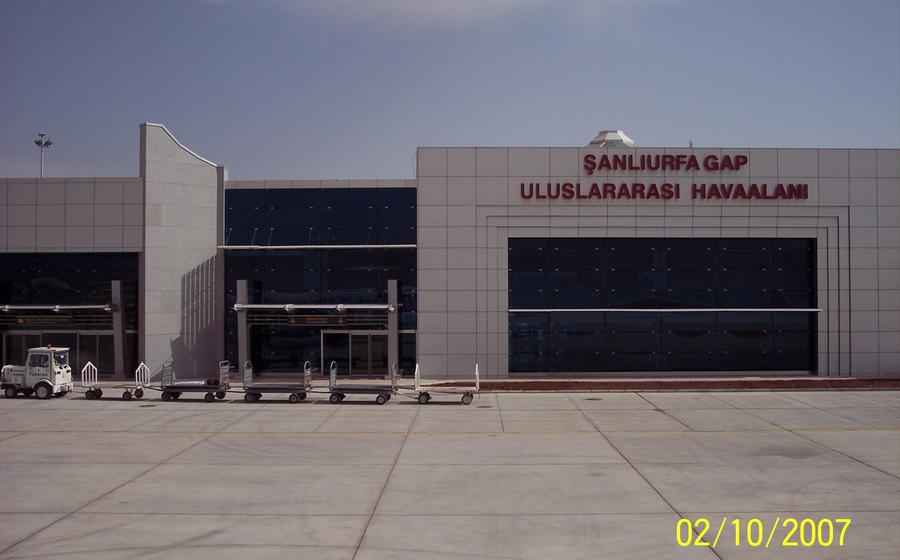
Kızılkoyun Inscriptions
- A Journey to Ancient History
- Location and Accessibility:
- Historical Context
- The Inscriptions Themselves
- Deciphering the Inscriptions
- Religious Significance
- Cultural Importance
- Preservation and Conservation: Protecting the Legacy of the Past
- Visiting the Site: Practical Tips for Travelers
- Local Cuisine and Hospitality
- Exploring Şanlıurfa
- Accommodation and Local Customs
- Language and Communication
- Safety and Security
- Insider Tip: Unveiling the Secrets of Şanlıurfa's Culinary Delights
A Journey to Ancient History
The Kızılkoyun Inscriptions stand as a testament to the rich history and diverse cultures that have shaped the region of Şanlıurfa. These inscriptions, etched into the rocks of southern Turkey, offer a glimpse into the lives and beliefs of ancient civilizations. Their historical significance lies in their ability to shed light on the political, religious, and cultural dynamics of the past.
The inscriptions date back to the 1st century BC and are attributed to the ancient kingdom of Commagene. This kingdom, ruled by a dynasty of Hellenized Armenian kings, played a significant role in the region's history. The inscriptions provide valuable insights into the kingdom's political structure, its relationship with neighboring empires, and its cultural influences.
Beyond their historical significance, the Kızılkoyun Inscriptions also contribute to our understanding of ancient civilizations in general. They offer a glimpse into the religious beliefs, social customs, and artistic expressions of the people who lived in this region over two thousand years ago. The inscriptions feature a variety of symbols, motifs, and iconography that provide clues about the daily lives, rituals, and artistic traditions of the ancient Commagenians.
Location and Accessibility:
The Kızılkoyun Inscriptions are situated in the enchanting city of Şanlıurfa, nestled in southeastern Turkey. The site lies approximately 10 kilometers northwest of the city center, amidst a tranquil and picturesque landscape. To reach the inscriptions, visitors can embark on a scenic 20-minute drive from Şanlıurfa, following well-maintained roads that offer breathtaking views of the surrounding countryside. Alternatively, for those seeking a more immersive experience, public transportation options are readily available, with regular buses departing from the city center and dropping off just a short walk away from the site.
Once you arrive at the Kızılkoyun Inscriptions, you'll find yourself surrounded by a cluster of ancient ruins and remnants of bygone eras. The site is well-maintained, with clearly marked paths and informative signposts that guide visitors through the various points of interest. As you explore the inscriptions, be sure to take in the stunning panoramic vistas of the surrounding landscape, which further enhances the overall experience.
If you're planning to visit the Kızılkoyun Inscriptions, consider combining your trip with other nearby attractions. Just a short distance away lies the world-renowned Göbekli Tepe, an archaeological marvel that dates back to the 10th millennium BCE and is believed to be one of the world's oldest temples. Other notable sites in the vicinity include the Şanlıurfa Museum, which houses a vast collection of artifacts from the region, and the Halfeti Village, a picturesque town built on the banks of the Euphrates River.
To make the most of your visit, plan your trip during the spring or fall months, when the weather is at its most pleasant. The mild temperatures and clear skies offer ideal conditions for exploring the inscriptions and the surrounding area.
Historical Context
The Kızılkoyun Inscriptions are located in a region with a rich and storied history. The area has been home to various civilizations, including the Hittites, Assyrians, Greeks, Romans, and Byzantines. Each civilization left its mark on the region, contributing to its cultural and historical tapestry.
During the Hellenistic period, the region was ruled by the Seleucid Empire. This period saw the rise of the city of Edessa, which became a major center of Hellenistic culture and learning. The city was home to a renowned library that housed a vast collection of books and manuscripts.
In the 1st century AD, the region came under Roman rule and became part of the Roman province of Syria. During this time, the city of Edessa continued to flourish and became a major center of Christianity. The city was home to a large Christian community and was the site of several important Christian councils.
In the 7th century AD, the region was conquered by the Arabs and became part of the Islamic caliphate. The city of Edessa was renamed Şanlıurfa and became a major center of Islamic culture and learning. The city was home to several important mosques and madrasas and became a center of Sufi mysticism.
The Inscriptions Themselves
The Kızılkoyun Inscriptions are a collection of ancient writings carved into the rock face of a hill overlooking the Harran Plain. They date back to the 9th century BC and are considered some of the most important historical artifacts in Turkey. The inscriptions are written in a variety of languages, including Luwian, Aramaic, and Phoenician, and they provide valuable insights into the history and culture of the region.
The inscriptions are of various sizes and shapes, ranging from small, simple carvings to large, elaborate panels. Some of the inscriptions are written in a clear and legible script, while others are more weathered and difficult to decipher. The content of the inscriptions is equally diverse, covering topics such as religious rituals, military campaigns, and economic transactions.
One of the most famous inscriptions is the "Stele of Kızılkoyun," which is a large stone panel that depicts a procession of gods and goddesses. The stele is covered in cuneiform script, which has been translated to reveal a detailed account of a religious ceremony. Another notable inscription is the "Kızılkoyun Bilingual," which is written in both Luwian and Phoenician. This inscription provides a valuable Rosetta Stone for understanding the Luwian language, which was spoken by the ancient Hittite Empire.
The Kızılkoyun Inscriptions are a testament to the rich cultural heritage of Şanlıurfa and the surrounding region. They offer a unique glimpse into the lives and beliefs of the ancient people who inhabited this area.
Deciphering the Inscriptions
Deciphering the Kızılkoyun Inscriptions has been a challenging task for scholars due to the ancient languages and scripts used. The inscriptions are written in a combination of Luwian hieroglyphs, Akkadian cuneiform, and Aramaic, requiring experts in each field to collaborate. The process of deciphering involved comparing the inscriptions with known texts in similar languages and studying the context and cultural background of the region.
One of the key breakthroughs in deciphering the inscriptions came from the discovery of a bilingual inscription written in both Luwian hieroglyphs and Akkadian cuneiform. This provided a Rosetta Stone-like key to understanding the Luwian language and allowed scholars to translate many of the inscriptions.
The decipherment of the Kızılkoyun Inscriptions has shed significant light on ancient civilizations in the region. They provide valuable information about the political, social, and religious practices of the people who inhabited the area centuries ago. These inscriptions have contributed to our understanding of the diverse cultures and languages that existed in the ancient Near East.
Religious Significance
The Kızılkoyun Inscriptions hold significant religious importance, offering insights into the spiritual beliefs and practices of the ancient people who created them. The inscriptions contain references to various religious figures, rituals, and deities, providing a glimpse into the religious landscape of the region. They shed light on the beliefs and practices of the people who inhabited this area, allowing us to understand their spiritual world and the role religion played in their daily lives.
The inscriptions mention several religious figures, including gods and goddesses, who were worshipped by the ancient population. These figures were believed to have control over various aspects of life, such as fertility, rain, and protection. The inscriptions also describe religious rituals and practices, such as offerings, prayers, and sacrifices, which were performed to appease the gods and seek their favor.
The religious significance of the Kızılkoyun Inscriptions is further highlighted by the presence of religious symbols and iconography. These symbols and images depict various deities, mythical creatures, and sacred objects, providing a visual representation of the religious beliefs of the time. The inscriptions also contain passages that invoke blessings and protection from the gods, indicating the deep reverence and devotion of the ancient people.
By studying the Kızılkoyun Inscriptions, we gain valuable insights into the religious beliefs and practices of the ancient people of Şanlıurfa. These inscriptions serve as a testament to the religious diversity and significance of the region throughout history.
Cultural Importance
The Kızılkoyun Inscriptions hold immense cultural significance, offering a glimpse into the daily lives and customs of the ancient people who inhabited the region. They provide valuable insights into the social structure, economic activities, and religious beliefs of the time. The inscriptions mention various cultural practices, such as festivals, rituals, and ceremonies, shedding light on the social interactions and community dynamics of the ancient society. Additionally, they contain references to local traditions, folklore, and mythology, providing a rich tapestry of cultural heritage that deepens our understanding of the region's past. These inscriptions serve as a testament to the cultural diversity and richness that characterized ancient civilizations, showcasing the vibrant tapestry of human expression and creativity.
Preservation and Conservation: Protecting the Legacy of the Past
The Kızılkoyun Inscriptions have faced the relentless passage of time and the elements. Harsh weather conditions, natural erosion, and human activities have taken their toll on these ancient texts. Recognizing the significance of these inscriptions, efforts have been made to preserve and conserve them for future generations.
Archaeologists and conservationists have undertaken meticulous restoration projects to repair damaged inscriptions and stabilize the site. Specialized techniques have been employed to clean, document, and protect the inscriptions from further deterioration. Ongoing monitoring and maintenance ensure that the inscriptions remain legible and accessible to scholars and visitors alike.
The local community and authorities play a crucial role in preserving the Kızılkoyun Inscriptions. Raising awareness about the site's importance, promoting responsible tourism, and implementing strict regulations to prevent vandalism are essential steps in safeguarding this precious heritage. By working together, we can ensure that the Kızılkoyun Inscriptions continue to inspire and educate generations to come.
Visiting the Site: Practical Tips for Travelers
Visiting the Kızılkoyun Inscriptions is an enriching experience that offers a glimpse into ancient history and culture. The site is open to the public, and visitors can explore the inscriptions at their leisure. Guided tours are available for those who want to delve deeper into the history and significance of the site. The inscriptions are located outdoors, so it's recommended to visit during the cooler months (October to April) for optimal weather conditions. To avoid crowds and ensure a peaceful viewing experience, it's best to visit early in the morning or late in the afternoon. Plan to spend at least an hour exploring the inscriptions and taking in the surrounding scenery. Combine your visit with other nearby attractions such as the Şanlıurfa Museum, which houses a collection of artifacts from the region, or the Göbekli Tepe archaeological site, which features some of the world's oldest known temples.
Local Cuisine and Hospitality
Şanlıurfa is renowned for its rich and flavorful cuisine, reflecting the city's diverse cultural heritage. Visitors should not miss the opportunity to savor local delicacies such as "Urfa kebabı", a skewer of grilled lamb seasoned with local spices, or "lahmacun", a crispy flatbread topped with minced meat, vegetables, and herbs. For a taste of traditional sweets, try "künefe", a crispy pastry filled with melted cheese and soaked in sweet syrup.
The people of Şanlıurfa are known for their warm hospitality and welcoming nature. Visitors are often invited to share a cup of tea or coffee in local cafes, where they can engage in friendly conversations and learn about the local culture. Restaurants and cafes in Şanlıurfa typically offer a welcoming atmosphere, where visitors can relax and enjoy their meals while immersing themselves in the local ambiance.
Food and hospitality hold a significant place in the culture of Şanlıurfa. The city's cuisine is a reflection of its diverse history and the influences of different civilizations that have shaped the region. The locals take pride in their culinary traditions and are eager to share them with visitors, making Şanlıurfa a delightful destination for food lovers and those seeking authentic cultural experiences.
Exploring Şanlıurfa
Beyond the Kızılkoyun Inscriptions, Şanlıurfa offers a wealth of attractions that immerse visitors in its rich history and vibrant culture. The city's historical center is a treasure trove of architectural wonders, including the majestic Şanlıurfa Castle, which offers breathtaking panoramic views of the city. The Grand Mosque, with its stunning Islamic architecture, is another must-see landmark. For a glimpse into the city's ancient past, visitors can explore the Şanlıurfa Museum, which houses a vast collection of artifacts from various civilizations that have called the region home.
For those seeking a unique cultural experience, the local markets and bazaars are a must-visit. The Covered Bazaar, with its labyrinthine alleys and colorful stalls, is a shopper's paradise, offering traditional handicrafts, jewelry, spices, and textiles. The Halfeti Bazaar, located in the nearby town of Halfeti, is renowned for its black roses, a unique local variety that blooms only in this region.
Nature enthusiasts can escape the city buzz and explore the stunning natural landscapes surrounding Şanlıurfa. The nearby Harran Plain, with its unique beehive-shaped houses, offers a glimpse into a traditional way of life. A boat trip on the Euphrates River, which flows through the city, provides a serene escape and an opportunity to witness the beauty of the riverbanks.
Accommodation and Local Customs
For a comfortable stay in Şanlıurfa, a range of accommodation options are available, catering to different budgets and preferences. From budget-friendly hostels and guesthouses to luxurious hotels, there's something to suit every traveler. When choosing a hotel, consider factors like location, amenities, and proximity to attractions.
To fully embrace the local culture, it's essential to be mindful of local customs and etiquette. Dress modestly in public, respecting the conservative nature of the region. When greeting people, offer a handshake with a warm smile. While Turkish is the primary language, basic English is understood in tourist areas. To enhance communication, consider learning a few Turkish phrases, as locals appreciate the effort. Avoid discussing sensitive topics like politics or religion, and always ask permission before taking photos of people.
By respecting local customs and interacting respectfully with the locals, you'll create a positive and memorable experience for yourself and contribute to preserving the cultural heritage of Şanlıurfa.
Language and Communication
The official language of Turkey is Turkish, and it is widely spoken in Şanlıurfa. While English is understood and spoken to some extent in tourist areas, it is not as prevalent as in other major cities in Turkey. To enhance your experience and connect with the locals, it is recommended to learn a few basic Turkish phrases or download language learning apps to familiarize yourself with the language. Many hotels and tour operators offer English-speaking services, but it is always helpful to have some basic Turkish communication skills. Embrace the opportunity to immerse yourself in the local culture and engage with the warm and welcoming people of Şanlıurfa through meaningful conversations and cultural exchanges.
Safety and Security
Şanlıurfa is generally considered a safe city for travelers, but as with any destination, it's important to take precautions to ensure your safety and security.
Be aware of your surroundings, avoid walking alone at night, and keep your valuables secure. It's advisable to carry a copy of your passport and visa, leaving the originals in a safe place at your accommodation.
If you're traveling during peak tourist season, be prepared for crowds, especially at popular attractions. It's always a good idea to research local customs and dress codes to avoid any misunderstandings or offense.
In case of an emergency, dial 112 for police, fire, or ambulance services. English-speaking assistance may be limited, so it's helpful to have a translation app or phrasebook on hand.
Remember, the local people are generally friendly and welcoming, and most are happy to help visitors. By being respectful and following these safety tips, you can have a safe and enjoyable experience in Şanlıurfa.
Insider Tip: Unveiling the Secrets of Şanlıurfa's Culinary Delights
For a truly unforgettable culinary experience in Şanlıurfa, venture off the beaten path and seek out the hidden gem known as "Kebapçı Halil Usta." Nestled in a quiet neighborhood, this unassuming eatery serves up some of the most delectable kebabs you'll ever taste. The menu is limited, but each dish is prepared with love and care, using fresh, local ingredients. Whether you opt for the classic lamb kebab or the succulent chicken shish, you're in for a flavor sensation that will leave you craving more. Pair your meal with a refreshing glass of ayran, a traditional yogurt drink, and savor the authentic taste of Şanlıurfa's culinary heritage.
